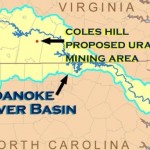 By Peter Galuszka
By Peter Galuszka
Virginia appears to be reaching a critical mass regarding uranium mining and milling in Pittsylvania County.
Today, the Uranium Working Group issued its report outlining what steps would be needed if Virginia were to lift its 30-year-old moratorium on uranium mining. Meanwhile, the powerful Virginia Farm Bureau joined a group of mining opponents including The Virginia Association of Counties, Virginia Beach and Norfolk which are strongly against lifting the ban.
Created by Gov. Robert F. McDonnell, the working group spent months researching what would need to be done if the ban were lifted and Virginia Uranium applied for permits to mine some 119 million pounds of uranium ore worth possibly $7 billion near Chatham. The group did not make any recommendations but is providing information should the General Assembly take up lifting the ban in January.
The report says there are two choices. Should Virginia regulate uranium mining and milling? Or should the milling operation be handled by the U.S. Nuclear Regulatory Commission which has the authority and experience to oversee it. (The NRC does not oversee mining but milling or refining ore).
If the state takes on the regulatory responsibility, it will need substantial new government resources including roughly 30 new professionals spread across such agencies as the Department of Mines Minerals and Energy, the Department of Health and the Department of Environmental Quality. They would cost maybe $5 million or more which the report says could be paid from fees charged mining firms. There wasn’t an estimate on local government costs.
The state would need authority from the NRC and that process could take three years. Only a handful of western states have it.
The state would still be involved if the NRC were to oversee milling. An environmental assessment must be done before mining operations are begun. Virginia would still have authority over air or water emissions from the uranium operation.
Uranium would take the state’s regulatory apparatus to a new level. Oversight would been needed for airborne radioactive emissions, drinking water, well-water, livestock within two miles of the operation, water for recreational swimming, worker safety, truck dust and a host of other matters. Financial safeguards in the forms of bonds would have to be paid upfront to protect against mishap plus plans for emergency responses would need to be put in place. (I’ll get into more as I digest the report).
In other words, it’s a very tall order. And, the report says it can’t be started unless the moratorium is lifted.
Interest in mining Southside Virginia uranium subsided after the ban 30 years ago but was renewed in 2007 at Coles Hill Farm when prices rebounded strongly. A new proposal by local residents and their Canadian investors has been racked by controversy ever since with company officials taking legislators on expenses-paid trips to France (Paris included), supposedly to gather information. There have been a series of studies including a couple by economists saying the proposal could bring in plenty of money and another by the National Academy of Sciences raising serious questions about safety, notably since Tidewater cities get their drinking water from lakes nearby.
If the ban is lifted, it still will be some years before Virginia could establish its complex regulatory structures if that’s what it chooses to do. Where uranium prices will be then is anyone’s guess. Spot prices for uranium yellowcake reached the mid $70s/pound level in early 2011 but took a huge tumble after the Fukushima reactor disaster in March of that year. They are now around $40/pound.
So, is it all worth the risk and hassle?


